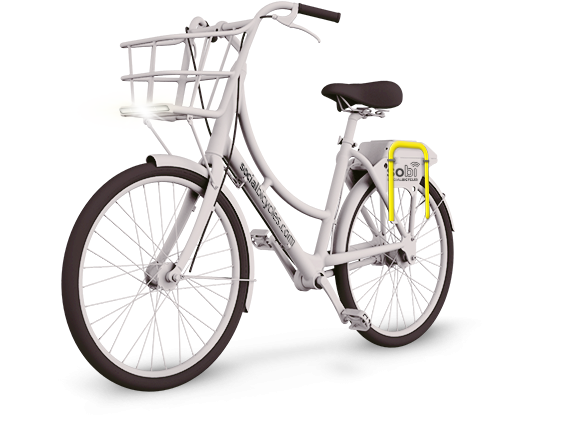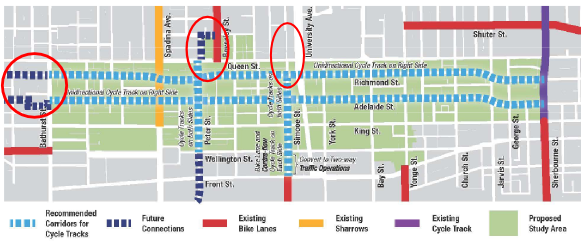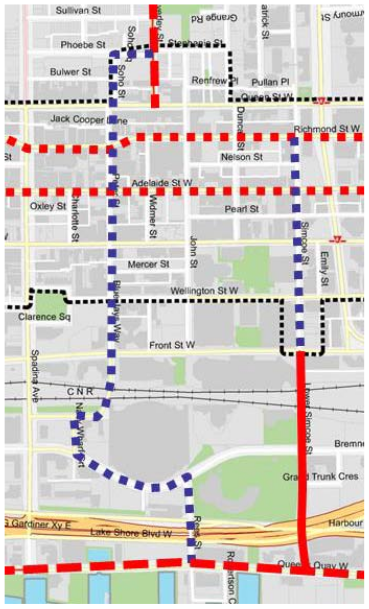At the recent Toronto Bike Awards, Dr. Monica Campbell won the TCAT Active Transportation Champion of the Year. Monica worked in Toronto Public Health to put a "health lens" on transportation planning. Monica is a leader in cycling issues but she is *not* an "avid cyclist". She only started cycling after BIXI Toronto launched. She has the perspective of someone who is interested in cycling but uncomfortable in heavy, fast traffic. In this way, Monica reflects an ongoing evolution of leadership in cycling infrastructure. Who are "avid cyclists"? Here's a clue: Some surviving avid cyclists (source), the three on left are members of the obscure but semi-powerful National Committee on Uniform Traffic Control Devices Bicycle Technical Committee (John Schubert, John Allen and John Ciccarelli, members of NCUTCDBTC, and New York bicycling advocate and planner Steve Faust), critiquing New York's cycling infrastructure. I don't think NYC asked the committee for permission before building those protected bike lanes. So if these guys are no longer driving the agenda, I guess that makes them backseat drivers. Such avid cyclists—many of whom can often be seen wearing cycling-specific gear and can be heard saying phrases like "Take The Lane" and "Cyclists fare best when they act and are treated as drivers of vehicles"—are increasingly being surpassed by a different breed in policy circles. The NCUTCDBTC, for their part, have approved a handful of bike symbols to be used on roads (like bike boxes that cities were building anyway) but for the most part have disapproved of the strong push for protected bike lanes and more "European" cycling infrastructure. By the nature of their minimal-intervention philosophy that appeals to only a tiny minority of the population, the avid cycling leaders are putting themselves out of a job. Instead, it's people like this who are changing the game:
 Mia Birk as Portland Bicycle Program Manager led a transformation of Portland into one of the bike-friendly cities in the United States. She's now a principal at Alta Planning & Design, a leading bicycle planning firm that also happens to operate many of the bikesharing programs that have mushroomed across North America. And also...
Mia Birk as Portland Bicycle Program Manager led a transformation of Portland into one of the bike-friendly cities in the United States. She's now a principal at Alta Planning & Design, a leading bicycle planning firm that also happens to operate many of the bikesharing programs that have mushroomed across North America. And also...  Janette Sadik Khan is the current head of NYDOT who revolutionized bicycle and pedestrian planning in New York and helped to spur on a nationwide push for better bicycle infrastructure (Photo: Momentum Magazine). She also was one of the key leaders in creating a new nationwide NACTO bike planning guide for transportation planners. They had decided if they couldn't change the highway planning agencies from the inside, they'd just set up their own. There were no transportation planning guides or committees in the US that permitted protected bike lanes, so the NACTO guide is now a competing guide in North America and one which the more ambitious cities will first turn to for advice.
Janette Sadik Khan is the current head of NYDOT who revolutionized bicycle and pedestrian planning in New York and helped to spur on a nationwide push for better bicycle infrastructure (Photo: Momentum Magazine). She also was one of the key leaders in creating a new nationwide NACTO bike planning guide for transportation planners. They had decided if they couldn't change the highway planning agencies from the inside, they'd just set up their own. There were no transportation planning guides or committees in the US that permitted protected bike lanes, so the NACTO guide is now a competing guide in North America and one which the more ambitious cities will first turn to for advice.  Sadik-Khan, seen here with former US Secretary of Transportation Ray LaHood and Congressman Earl Blumenauer, launching the NACTO guide. **Evolution in local leaders** Increasingly these policy makers are not the gear heads, "avid" cyclists and the road warriors - the survivors when everyone else stopped cycling. I'll happily put myself in the category of a reforming avid cyclist. Instead the leaders are increasingly women and men who are intensely interested in making cycling (and walking) safer for their families. In Dr. Campbell's case, she had only taken up cycling when BIXI Toronto was launched. And after being hit while using BIXI, has worked to make cycling safer. The result is that Toronto Public Health is now starting to "invade" the domain of the male-dominated Transportation Services by getting them to consider safety. Duh. To the average person as well as to Public Health it doesn't make sense why this isn't already a prime concern for the engineers. (I'd be remiss if I didn't mention that there are actually a handful of female cycling planners who have also done great work in upsetting the applecart.) I think there is a clear correlation of the increase in cycling, increase in safer cycling infrastructure and that the policy makers and leaders are increasingly women. And the avid cyclists/road warriors are making themselves extinct. *Corrections: Sadik-Khan is the soon to be the former head of NYCDOT. In the top photo only the left three are committee members. I made the source of the top photo more explicit and added the names of the people in the photo, instead of just linking "avid cyclists" to the source. And yes, not all avid cyclists have new bike gear, just the majority. I've removed this line "I don't imagine she's got the gear: no special shoes, padded shorts, stretchy fabric." because I think it's just a distraction from my message.*
Sadik-Khan, seen here with former US Secretary of Transportation Ray LaHood and Congressman Earl Blumenauer, launching the NACTO guide. **Evolution in local leaders** Increasingly these policy makers are not the gear heads, "avid" cyclists and the road warriors - the survivors when everyone else stopped cycling. I'll happily put myself in the category of a reforming avid cyclist. Instead the leaders are increasingly women and men who are intensely interested in making cycling (and walking) safer for their families. In Dr. Campbell's case, she had only taken up cycling when BIXI Toronto was launched. And after being hit while using BIXI, has worked to make cycling safer. The result is that Toronto Public Health is now starting to "invade" the domain of the male-dominated Transportation Services by getting them to consider safety. Duh. To the average person as well as to Public Health it doesn't make sense why this isn't already a prime concern for the engineers. (I'd be remiss if I didn't mention that there are actually a handful of female cycling planners who have also done great work in upsetting the applecart.) I think there is a clear correlation of the increase in cycling, increase in safer cycling infrastructure and that the policy makers and leaders are increasingly women. And the avid cyclists/road warriors are making themselves extinct. *Corrections: Sadik-Khan is the soon to be the former head of NYCDOT. In the top photo only the left three are committee members. I made the source of the top photo more explicit and added the names of the people in the photo, instead of just linking "avid cyclists" to the source. And yes, not all avid cyclists have new bike gear, just the majority. I've removed this line "I don't imagine she's got the gear: no special shoes, padded shorts, stretchy fabric." because I think it's just a distraction from my message.*
- 17 comments
Hamilton is getting bikesharing by next year, reports Raise the Hammer. Instead of BIXI, the system that has been installed in all the major North American cities with bikesharing, the winning bidder was a new kid on the block, Social Bicycles. Apparently BIXI was disqualified on a technicality, but that doesn't necessarily mean that Social Bicycles wouldn't have won. Hamilton is purchasing the system with funds from Metrolinx.

Unlike BIXI and similar systems like Velib in Paris where there are stations that contain the "brains" of the operations, Social Bicycles worked to squeeze all the brains (GPS, pin pad and batteries) onto the bike. In some ways it harkens back to an older model of bikesharing, Call a Bike in Germany (but a lot less ugly). They claim that it's a cheaper way to operate and that since the bike can be locked up anywhere that people won't be stuck with a full station.
There are potential drawbacks in my mind. It's probably harder to find a bike. They've mitigated that by having a smartphone app and by providing financial incentives for people to lock up in a zone instead of just anywhere. And I'd be interested to see if the bikes are as durable as BIXI's.
So far they've only operated on a small scale in a handful of medium-sized cities like Tampa Bay, Buffalo. Hamilton's system of 650 bikes will be a major test of its viability.
It'll be interesting to compare it to Toronto's BIXI. Will it be easier to expand and operate Social Bicycles?

Staff seem to be half-hearted in ensuring that Peter and Simcoe (and Richmond and Adelaide for that matter) are properly connected to the wider network.
Don't get me wrong, the east-west routes look to be awesome. And north-south they've done a half-decent job of trying to make sure there's separation. The big issue is that the staff seem to have decided that they don't find it important to design the lanes so people can safely get into them or off of them (their proposals, booklet). The pinch points:
- Crossing Bathurst will still be a pain. The map just punts the crossings to the "future".
- They've been unclear if they'll include a connection between Peter and Beverley. The map above says "future connection" but staff also said they reviewing modifying the Queen St intersection and connecting via Soho and Phoebe.
- They have no plans to make it easy to cross Queen at Simcoe. Traffic lights are probably the only thing that will make it easy to cross. If we don't get that people just won't use it.
- On the south end the bike lanes just end at Wellington and Peter. And on Simcoe cyclists must continue on unprotected bike lanes for the rest of the trip to the lake.
The interesting thing is that Peter and Simcoe were part of the "Ward 20 bike plan" that Councillor Adam Vaughan presented a few years ago:

The staff need to feel a bit of heat. And it wouldn't hurt to email Councillor Vaughan and let him know you support his proposals for Peter and Simcoe.
And, oh, let the staff know you're not pleased with their pilot project plan. The risk is that a pilot will endanger a permanent installation. The pilot as it stands is likely both too small and too temporary (just 3 months or so) to provide good results to let us know if the lanes will be popular. If they go forward with a pilot they should be doing a lot of promotional work and provide good connections to make sure cyclists know about it and are willing to use it.
See jnyzz's blog post for more commentary.
- ‹ previous
- Page 30
- next ›
